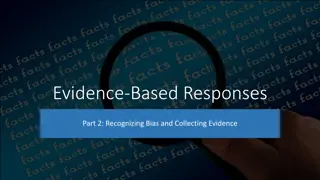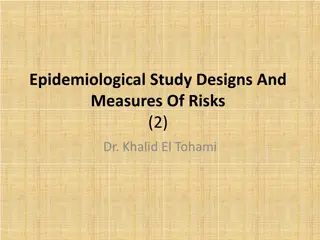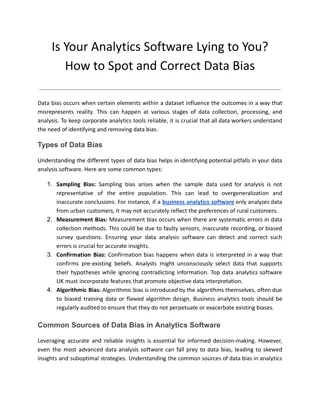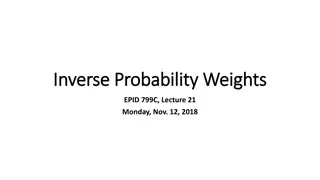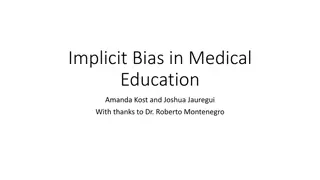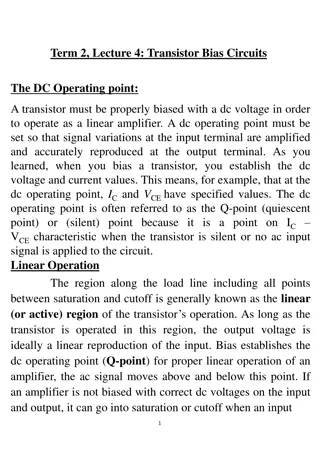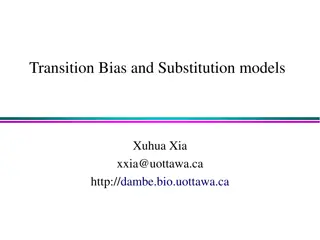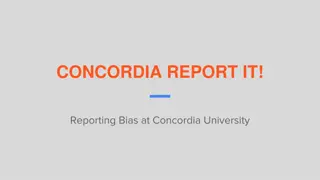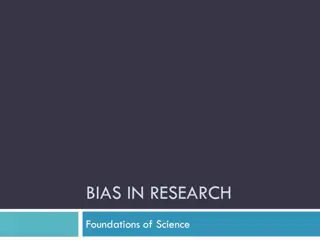Types of Bias in Epidemiological Studies
Bias in epidemiological studies can arise from misclassification of observations and exposures, leading to incorrect associations between variables. Observation bias, misclassification bias, and non-differential misclassification can impact the accuracy of study results, either minimizing differences or exaggerating associations. Understanding the sources and effects of bias is crucial in ensuring the validity of research findings.
Download Presentation

Please find below an Image/Link to download the presentation.
The content on the website is provided AS IS for your information and personal use only. It may not be sold, licensed, or shared on other websites without obtaining consent from the author.If you encounter any issues during the download, it is possible that the publisher has removed the file from their server.
You are allowed to download the files provided on this website for personal or commercial use, subject to the condition that they are used lawfully. All files are the property of their respective owners.
The content on the website is provided AS IS for your information and personal use only. It may not be sold, licensed, or shared on other websites without obtaining consent from the author.
E N D
Presentation Transcript
Observation Bias (Information Bias) Biased measure of association due to incorrect categorization. Diseased Not Diseased Exposed The Correct Classification Not Exposed
Observation Bias (Information Bias) Biased measure of association due to incorrect categorization. Diseased Not Diseased Exposed Errors in Classification Not Exposed
Misclassification Bias Subjects are misclassified with respect to their risk factor status or their outcome, i.e., errors in classification. Non-differential Misclassification (random): If errors are about the same in both groups, it tends to minimize any true difference between the groups (bias toward the null). Errors Errors = Differential Misclassification (non-random): If information is better in one group than another, the association maybe over- or underestimated. Errors Errors
Non-Differential Misclassification = Errors Errors When errors in exposure or outcome status occur with approximately equal frequency in groups being compared. 1. Equally inaccurate memory of exposures in both groups. Example: Case-control study of heart disease and past activity: difficulty remembering your specific exercise frequency, duration, intensity over many years 2. Recording and coding errors in records and databases. Example: ICD-9 codes in hospital discharge summaries. 3. Using surrogate measures of exposure: Example: Using prescriptions for anti-hypertensive medications as an indication of treatment 4. Non-specific or broad definitions of exposure or outcome. Example: Do you smoke? to define exposure to tobacco smoke (vs. How much, how often, how long). CHD?
Non-Differential Misclassification = Errors Errors Effect: With a dichotomous exposure (e.g., smoking vs. non-smoking), non-differential misclassification minimizes differences & causes an underestimate of effect, i.e. bias toward the null. Null means no difference 0.3 0.5 1.0 2 3 Relative Risk
Differential Misclassification Errors Errors When errors in classification of exposure or outcome are more frequent in one group. Differences in accurately remembering exposures (unequal) Example: Mothers of children with birth defects will remember the drugs they took during pregnancy better than mothers of normal children (maternal recall bias). Interviewer or recorder bias. Example: Interview has subconscious belief about the hypothesis. More accurate information in one of the groups. Example: Case-control study with cases from one facility and controls from another with differences in record keeping.
(Differential) Recall Bias Errors Note: If the groups have the same % of errors based on faulty memory, that s non-differential misclassification. People with disease may remember exposures differently (more or less accurately) than those without disease. Errors Example: A case-control study of heart malformations in newborn infants. Cases group is mothers of infants with defects. Controls are mothers of normal infants. Both groups are asked about medication use during pregnancy. Of course, mothers of infants with defects will have already spent hours thinking about what might have caused the defect. Was it something I took?
(Differential) Interviewer Bias (& recorder bias in record reviews) Are you sure? Think harder! Errors Errors Systematic differences in soliciting, recording, or interpreting information. Interviewer Example: (The same case-control study on birth defects.) The interviewer believes that SSRIs are a cause of heart defects. Subconsciously, he probes harder when interviewing the mothers of the children with defects. Are you sure you didn t take any SSRIs? Perhaps you borrowed some from a friend. -------------- Can also occur when reviewing records (e.g., the incidental appendectomy study.



